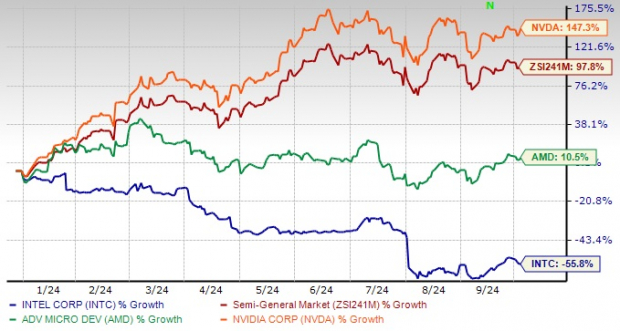
Intel Corporation INTC has plunged 55.8% year to date against the industry’s growth of 97.8%, lagging its peers Advanced Micro Devices, Inc. and NVIDIA Corporation. Much of this underperformance is due to severe financial difficulties and operational challenges, which have forced management to undertake a comprehensive review of its businesses.
Intel is mulling various options, including the potential split of its product design and manufacturing divisions and evaluating which factory projects should be terminated. It also plans to establish Intel Foundry as an independent subsidiary to unlock strategic benefits and improve capital efficiency with clearer separation and independence from the rest of Intel. The division incurred an operating loss of $2.8 billion in the last reported quarter.
YTD Price Performance

Image Source: Zacks Investment Research
INTC Plagued by Margin Woes
Intel is expanding its artificial intelligence footprint to edge devices and PCs with its Core Ultra processors, supporting more than 100 software vendors and 300 AI models. The new Lunar Lake architecture, featuring advanced graphics and AI processing power, promises significant performance and energy efficiency improvements. Additionally, Intel’s updates on next-generation products across all segments of enterprise AI, including the new Intel Xeon 6 processors and Intel Core Ultra client processors, further solidify its position as a frontrunner in the AI revolution.
The company has introduced the Intel Gaudi 3 accelerator and a suite of open, scalable systems for AI adoption across various sectors. Equipped with up to tens of thousands of accelerators interconnected through Ethernet, the Gaudi 3 accelerator promises a substantial boost in AI training and inference capabilities, enabling global enterprises to deploy AI at scale with ease.
However, an accelerated ramp-up of AI PCs for an early-mover advantage has significantly affected its short-term margins, as Intel shifted production to its high-volume facility in Ireland, where wafer costs are typically higher. Margins were also adversely impacted by higher charges related to non-core businesses, charges associated with unused capacity and an unfavorable product mix. Competitive pricing pressures from rivals have further dented its profitability.

Image Source: Zacks Investment Research
Soft China Market, Frigid Trade Ties Hurt INTC
China accounted for more than 27% of Intel’s total revenues in 2023, making it the single largest market for the company. However, the communist nation’s purported move to replace U.S.-made chips with domestic alternatives significantly affected its revenue prospects. The recent directive to phase out foreign chips from key telecom networks by 2027 underscores Beijing’s accelerating efforts to reduce reliance on Western technology amid escalating U.S.-China tensions.
As Washington tightens restrictions on high-tech exports to China, Beijing has intensified its push for self-sufficiency in critical industries. This shift poses a dual challenge for Intel, as it faces potential market restrictions and increased competition from domestic chipmakers. The second-quarter 2024 revenues were adversely impacted by the revocation of certain licenses for exports of consumer-related items to a customer in China.
Moreover, weaker spending across consumer and enterprise markets, especially in China, resulted in elevated customer inventory levels. Management expects customers to reduce inventory over the second half of the year, resulting in soft demand trends. Strict export control measures are further likely to affect the market dynamics, leading to below-par revenue growth in the near term, with the client business flat to down and modest growth in data center and edge markets.
Estimate Revision Trend of INTC
Earnings estimates for Intel for 2024 have moved down 83.9% to 27 cents over the past year, while the same for 2025 has declined 41.1% to $1.09. The negative estimate revision depicts bearish sentiments for the stock.

Image Source: Zacks Investment Research
End Note
Intel’s innovative AI solutions hold immense promise for the broader semiconductor ecosystem. By addressing the challenges of scalability, performance and interoperability, it is paving the way for widespread AI adoption across enterprises worldwide.
However, with a Zacks Rank #4 (Sell), it appears that the recent product launches are “too little too late” for Intel. In addition, margin woes amid strict export restrictions, unfavorable product mix and elevated customer inventory levels weigh on its bottom line. With declining earnings estimates and abysmal price performance compared with its peers, the stock is witnessing a negative investor perception. Consequently, it might not be prudent to bet on the stock at the moment.
Market News and Data brought to you by Benzinga APIs
© 2024 Benzinga.com. Benzinga does not provide investment advice. All rights reserved.


